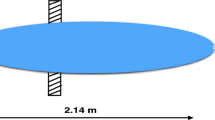Abstract
A novel hybrid control approach is presented for trajectory tracking control of unmanned underwater vehicles in this paper. The kinematic and dynamic controllers are integrated by the proposed control strategy. The paper has two objectives. Firstly, an improved backstep method is proposed to generate the virtual velocity using a bio-inspired neurodynamics model in the kinematic controller. The bio-inspired neurodynamics model is intended to smooth the virtual velocity output to avoid speed jumps of the unmanned underwater vehicle caused by tracking errors and to meet the thruster control constraints. Secondly, a new sliding-mode method is added to the dynamic controller, which is robust against parameter inaccuracy and disturbances. The combined kinematic–dynamic control law is applied to the trajectory tracking problem of two different types of unmanned underwater vehicle. Finally, simulation results illustrate the performance of the proposed controller.












Similar content being viewed by others
References
Antonelli G, Chiaverini S, Sarkar N, West M (2001) Adaptive control of an autonomous underwater vehicle: experimental results on ODIN. IEEE Trans Control Syst Technol 9(5):756–765
Antonelli G, Caccavale F, Chiaverini S (2003) A novel adaptive control law for underwater vehicles. IEEE Trans Control Syst Technol 11(2):221–232
Healey A, Lienard D (1993) Multivariable sliding mode control for autonomous diving and steering of unmanned underwater vehicles. IEEE J Ocean Eng 18(3):327–339
Wallace MB, Max SD, Edwin K (2008) Depth control of remotely operated underwater vehicles using an adaptive fuzzy sliding mode controller. Robot Auton Syst 56(8):670–677
Serdar S, Bradley JB, Ron PP (2008) A chattering-free sliding-mode controller for underwater vehicles with fault-tolerant infinity-norm thrust allocation. Ocean Eng 35:1647–1659
agheri A, Moghaddam J J (2009) Simulation and tracking control based on neural-network strategy and sliding-mode control for underwater remotely operated vehicle. Neurocomputing 72(7–9):1934–1950
Santhakumar M, Asokan T (2010) Investigations on the hybrid tracking control of an underactuated autonomous underwater robot. Adv Robot 24(11):1529–1556
Fierro R, Lewis FL (1997) Control of a nonholonomic mobile robot: backstepping kinematics into dynamics. J Robot Syst 14(3):149–163
Yang S X, Luo C (2004) A neural network approach to complete coverage path planning. IEEE Trans Syst Man Cybern B Cybern 34(1):718–725
Luo C, Yang SX (2008) A bio-inspired neural network for real-time concurrent map building and complete coverage robot navigation in unknown environment. IEEE Trans Neural Netw 19(7):1279–1298
Lapierre L, Jouvencel B (2008) Robust nonlinear path-following control of an AUV. IEEE J Ocean Eng 33(2):89–102
Jon ER, Asgeir JS, Kristin YP (2008) Model-based output feedback control of slender-body underactuated AUVs: theory and experiments. IEEE Trans Control Syst Technol 16(5):930–946
Ishii K, Ura T (2000) An adaptive neural-net controller system for an underwater vehicle. Control Eng Pract 8:177–184
Kodogiannis V (2003) Direct adaptive control of underwater vehicles using neural networks. J Vibr Control 9:605–619
Pepijn WJ, Colinvan VF, Daniel T (2005) Neural network control of underwater vehicles. Eng Appl Artif Intell 18:533–547
Bagheri A, Karimi T, Amanifard N (2010) Tracking performance control of a cable communicated underwater vehicle using adaptive neural network controllers. Appl Soft Comput 10(3):908–918
Wai R J (2007) Fuzzy sliding-mode control using adaptive tuning technique. IEEE Trans Ind Electron 54:(1):586–594
Ishaque K, Abdullah S S, Ayob S M, Salam Z (2010) Single input fuzzy logic controller for unmanned underwater vehicle. J Intell Robot Syst 59(1):87–100
Zhang LJ, Qi X, Pang YJ (2009) Adaptive output feedback control based on DRFNN for AUV. Ocean Eng 36(9):716–722
Antonelli G, Chiaverini S (2003) Fuzzy redundancy resolution and motion coordination for underwater vehicle-manipulator systems. IEEE Trans Fuzzy Syst 11(2):109-120
Serdar S, Bradley JB, Ron PP (2010) Redundancy resolution for underwater mobile manipulators Ocean Eng 37(2–3):325-343
Hodgkin AL, Huxley AF (1952) A quantitative description of membrane current and its application to conduction and excitation in nerve. J Physiol 117(4):500–544
Stephen G (1988) Nonlinear neural networks: principles, mechanisms, and architecture. Neural Netw 1(1):17–61
Do K D, Jiang Z P, Pan J , Nijmeijer H (2004) A global output-feedback controller for stabilization and tracking of underactuated ODIN: a spherical underwater vehicle. Automatica 40(1):117–124
Edin O, Geoff R (2004) Thruster fault diagnosis and accommodation for open-frame underwater vehicles. Control Eng Pract 12(12):1575–1598
Ge SS, Sun ZD, Lee TH (2001) Feedback linearization and stabilization of second-order non-holonomic chained systems International J Control 74(14):1383–1392
Pan LX, Jin HZ, Wang LL (2011) Robust control based on feedback linearization for roll stabilizing of autonomous underwater vehicle under wave disturbances China Ocean Eng 25(2):251–263
Petrich J, Stilwell DJ (2011) Robust control for an autonomous underwater vehicle that suppresses pitch and yaw coupling. Ocean Eng 38(1):197–204
Feng Z, Allen R (2004) Reduced order H control of an autonomous underwater vehicle. Control Eng Pract 12(12):1511–1520
Acknowledgments
This project is supported by the National Natural Science Foundation of China (51075257) and the Creative Activity Plan for Science and Technology Commission of Shanghai (10550502700), the Yangtze River Delta Region scientific and technological project (10595812700).
Author information
Authors and Affiliations
Corresponding author
About this article
Cite this article
Sun, B., Zhu, D., Ding, F. et al. A novel tracking control approach for unmanned underwater vehicles based on bio-inspired neurodynamics. J Mar Sci Technol 18, 63–74 (2013). https://doi.org/10.1007/s00773-012-0188-8
Received:
Accepted:
Published:
Issue Date:
DOI: https://doi.org/10.1007/s00773-012-0188-8




